

Expert dental tips, news, and smile advice
Thanksgiving Tooth Troubles? Enjoy the Feast Without the Pain
November 12, 2025
On the Wednesday before Thanksgiving, Lauren did everything right. She packed the kids’ pajamas, thawed the cranberry sauce she swears tastes better than homemade, and took the dog to the sitter. By the time the sweet, buttery smell of roasted pecans filled her parents’ kitchen in Milton, she finally let herself relax. Then, during the first test slice of pie, a dull jab pulsed through her lower right molar—quick, like a pinched nerve, then gone. She chewed on the other side and pretended not to notice.
By Thursday afternoon, it wasn’t pretending anymore. A forkful of turkey felt fine. One bite of candied pecans sent a sharp zing that made her put the fork down. Great, she thought, three days off and now this tooth wants attention. She did that thing we all do: the tiny tongue nudge, the gentle “test bite,” the mental bargaining. Could she ride it out? Was she overreacting? Would calling a dentist on a holiday feel like making too big a deal?
If you’ve ever had a tooth pipe up right when the table is full and everyone’s watching the rolls, you’re not alone. This is the season of surprise cracks, stubborn sensitivity, and the kind of sticky sweets that find every vulnerable corner. The good news is you can still enjoy your Thanksgiving—with comfort and confidence—once you understand why these pains flare and what actually helps.
What’s Really At Stake (And It’s Not Just A Tooth)
It’s the small joys: the first bite of your aunt’s pecan pie, the way your turkey sandwich tastes on Friday, laughing without pressing your tongue against the sore spot. Pain steals attention. It turns every plate into a strategy puzzle—left side only, nothing crunchy, sip water first. Our goal is to hand your attention back to the people in front of you and the food you love, while protecting the long-term health of your teeth.
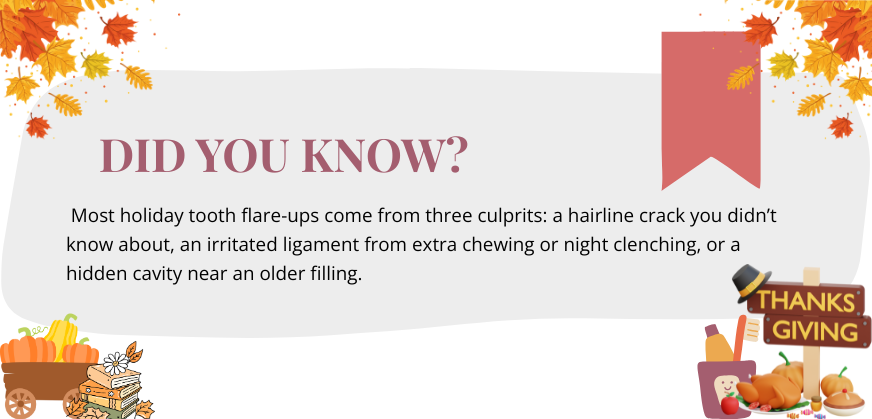
Why Thanksgiving Can Trigger Tooth Pain
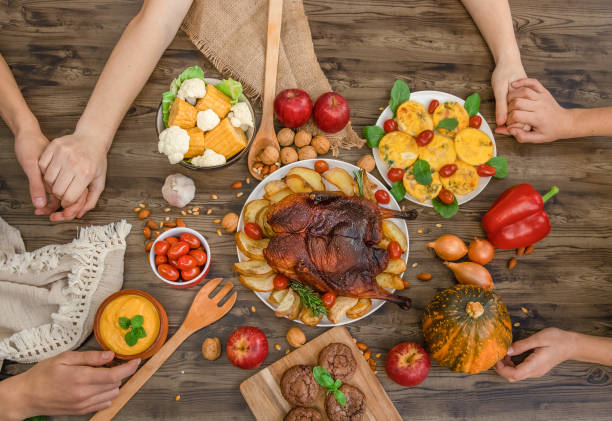
Sticky, crunchy, cold, sweet—your mouth’s obstacle course
Holiday plates stack contrasting textures: crisp green beans, chew-heavy turkey, sugar-dense desserts, ice-cold drinks. If a tooth or its supporting ligament is on the edge—slightly inflamed, slightly cracked, or slightly high in the bite—those contrasts reveal the weak link.
Stress and sleep
A full house, travel, and big emotions can mean clenched jaws at night. Clenching loads your teeth like a weight rack—especially the molars—so a minor high point or older filling becomes a tender target.
“I’ll catch up in January” dentistry
It’s common to push routine care to the new year. That small twinge from October? Two months later, candied nuts turn it into a headline. Don’t feel bad; it’s human. Just know there’s a better path.
Lauren’s Quiet Fork-in-the-Road
After the second zing, Lauren did something brave. She stepped into the pantry, took a breath, and let herself admit: This isn’t in my head. When she messaged us, we had a plan by the time the gravy cooled. And that’s the pivot point for most people—the moment you trade guessing for guidance.
If that’s you today: We set aside time for urgent visits around the holidays because life doesn’t schedule dental issues. Start here so we can triage and prioritize comfort: Emergency Dentistry.
What That Bite-Down Pain Really Means
1. The quick zap that vanishes
Sharp pain on pressure that fades when you release is classic for a flexing cusp—often a thin crack. Picture a door with a loose hinge: push, it shifts; let go, it settles. A well-fitted dental crown or sometimes a conservative onlay acts like a seatbelt so the crack can’t open with every chew.
2. The bruise-like throb
If you’ve bitten something hard recently or clenched overnight, the ligament that suspends the tooth can get irritated. Biting feels sore, but temperature isn’t dramatic. A precise bite adjustment and a few days of gentler chewing often calm it. If clenching is a pattern, a custom nightguard protects your teeth during the most stressful week of the year.
3. The stubborn sweet sting
If sweets or cold cause a spark that lingers, you may have a cavity near the contact or an older filling that’s leaking at the edge. Sugar sneaks in; the tooth sends a signal. Treatment depends on how much healthy structure we can preserve: a bonded filling for small areas; a crown when strength and seal matter most.
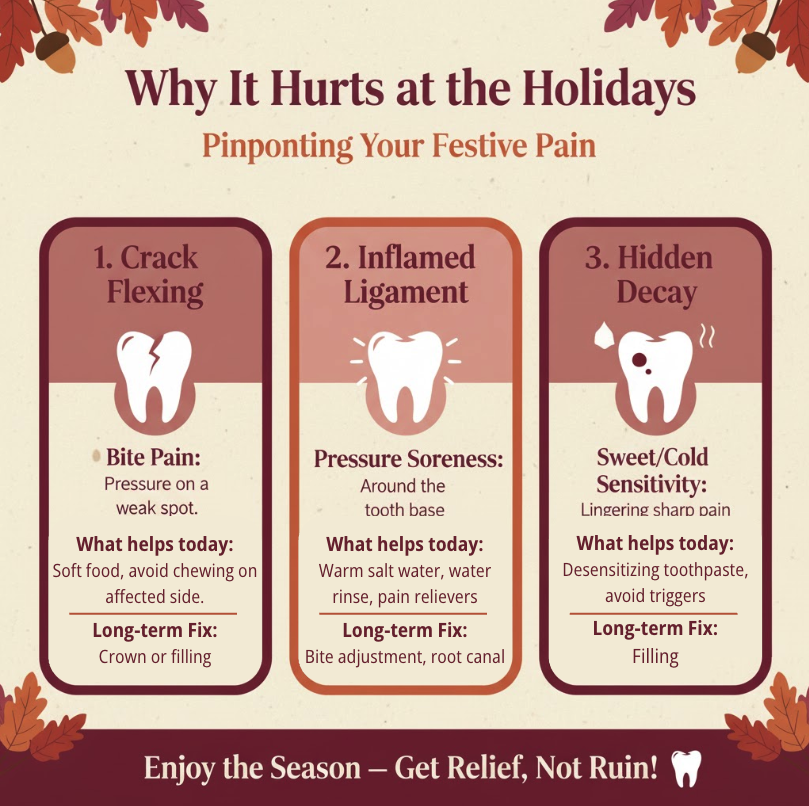
First-Aid Moves That Actually Help (And What To Skip)
- Rinse and reset. Warm water swish clears crumbs from tiny grooves and calms tissues.
- Protect sharp edges. If a cusp chipped and feels rough, a dab of orthodontic wax can soften it until we see you.
- Use ice smartly. Cold on the cheek in short intervals reduces swelling. Avoid putting ice on the tooth itself.
- Pain meds with food. Over-the-counter options can help you enjoy dinner, but take with a snack and water to protect your stomach.
- Skip hard tests. Don’t “prove” it doesn’t hurt by biting a pecan again. Your tooth isn’t bluffing.
- No DIY glues. Temporary cements and household adhesives cause more harm than help. Save any broken piece; we’ll handle the rest.
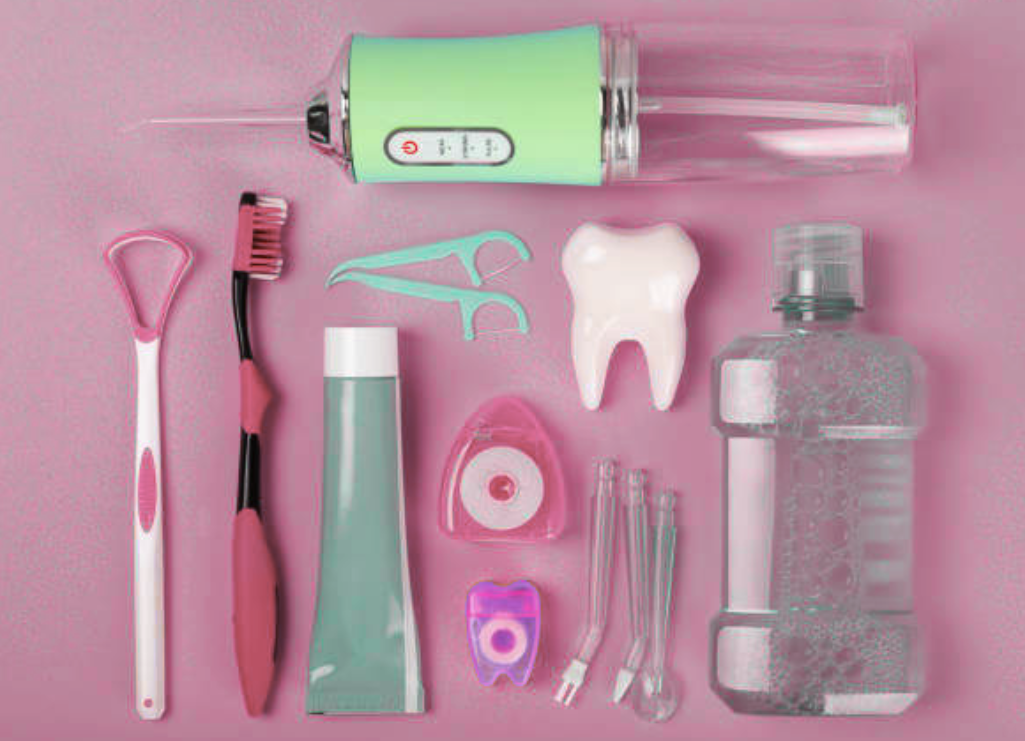
What Happens When You Come In (And Why It’s Calming)
We start with a conversation—when did this start, what foods set it off, any recent work—then we gather a few targeted clues. Light taps check the ligament; thin paper shows which cusp is bearing the load; a brief temperature test tells us how the nerve is feeling. Often, we’ll take magnified photos so you can literally see what we see. The path forward becomes obvious together: polish a high spot, stabilize a cracked cusp, treat decay conservatively, or—rarely—map a replacement if the tooth can’t be predictably saved.
When stabilization is step one, we make sure you leave comfortable: smoothing a rough edge, placing a protective temporary, or balancing the bite so chewing feels normal again.
The Menu, Decoded: How To Eat Well Without Flinching
- Turkey & proteins - Shred or slice across the grain and moisten with gravy. Chew on the comfortable side if one area is tender.
- Sides - Mashed potatoes, roasted carrots, and soft rolls are friendly; raw carrots or crisp sourdough might be pushy for a day.
- Desserts - Pie is usually fine if nuts are chopped small. Sticky toffees and hard brittle are where chips and cracks like to happen.
- Drinks - Ice water can trigger sensitivity; room-temp water is kinder. Red wine and cranberry sauce stain—rinse with water right after if a bright smile matters for photos.
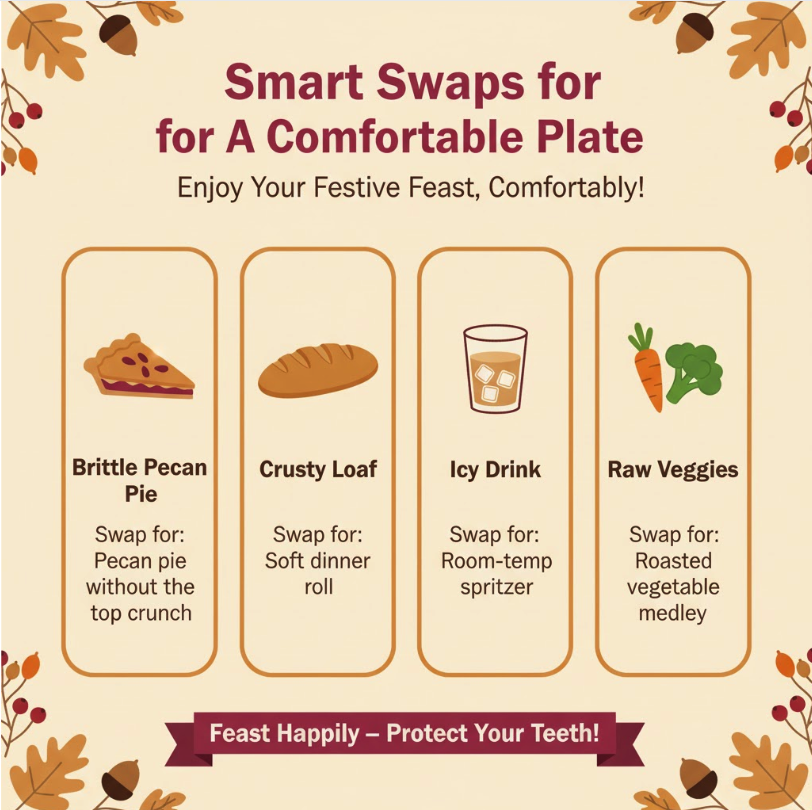
Lauren’s Turning Point (And How The Story Ends)
Her exam showed a hairline crack along the outer cusp—no drama on cold, but a quick zing on bite pressure. We polished the bite to take stress off the area and placed a protective temporary that kept the crack from flexing. Dinner was back on. The following week, after the family flew home, we seated a ceramic crown that matched her natural shade. At the check a month later, Lauren said, “I forgot which tooth it was until you asked.” That’s the measure of success: steady comfort that lets you forget about your teeth and focus on everything else that makes the season good.
Ready to Transform Your Smile?
Don’t white-knuckle your way through the holiday. If you felt a crack, have bite pain, or your sweet tooth sets off a sting, we can help you enjoy the feast without flinching. Book an urgent visit here: Emergency Dentistry. Prefer to plan a post-holiday fix that lasts? Explore Dental Crowns for cracked or heavily filled teeth.
Discover the best solution for your smile at Method Modern Dentistry. Schedule your appointment now and let our expert team guide you to a confident, healthy smile.

The After-Thanksgiving Plan That Saves You Headaches (And Money)
1. Stabilize now, strengthen soon
If we protected a cracked cusp or adjusted your bite to calm pain, the next step is a lasting solution—often a crown for strength or a conservative filling when structure allows. We’ll weigh cost, longevity, and your habits together so you don’t pay the “redo tax” on a fix that can’t hold up.
2. Clean edges, happy gums
Crowns don’t get cavities; teeth do—especially at the seam where crown meets gum. A soft-bristle brush angled at the gumline and nightly flossing protect that margin. If floss keeps shredding around a tight contact, tell us; a simple polish can turn nightly flossing from “ugh” to automatic. For rhythm and results, see Preventative Care.
3. Stains happen—plan your glow-back
Cranberry sauce and red wine are festive, not fatal. If your smile looks a shade darker after the season, a thoughtful teeth whitening plan can reset your color before family photos or year-end events. We calibrate to your enamel and sensitivity so results look bright and believable, not overdone.
What If The Tooth Can’t Be Saved?
Sometimes a crack runs too deep or decay has undermined the core. When keeping the tooth would set you up for repeat emergencies, removing it can be the healthiest choice. Replacing a missing tooth preserves chewing, speech, and the alignment of neighbors. That’s where a single tooth dental implant often shines—natural look, stable bite, and no stress on adjacent teeth. We’ll map timelines, comfort, and budget so the process feels clear rather than overwhelming.

Your Thanksgiving-Ready Checklist
- Listen to the first twinge. If something zings, switch to softer textures and reach out.
- Choose comfort-friendly portions. Small bites, chew on the easy side, sip water.
- Protect at night. If you clench, a nightguard is a tiny investment that saves big dentistry.
- Ask for help. Quick messages now beat urgent calls later. We’re here for real life, not just perfect timing.
FAQs
Why do sweet foods hurt even if chewing is okay?
Sweets can slip under the edge of an older filling or into a small cavity and irritate the inner layer of the tooth. That quick sting is your tooth’s way of flagging a leak in the seal. We’ll test the area gently and recommend a bonded filling or crown depending on how much strong tooth remains. The good news: treating the cause usually stops the sweet sensitivity fast.
Can I wait until after the holiday to be seen?
If pain is mild and intermittent, you may be okay for a day or two with soft foods and care. But if biting triggers a sharp jab, if a piece chipped, or if you notice swelling, it’s smarter to come in sooner. Early visits are almost always simpler, more comfortable, and more affordable than the “wait and see” version. Use our Emergency Dentistry page to grab a time.
Will I definitely need a crown if I felt a crack?
Not always. Tiny chips or shallow cracks can sometimes be repaired conservatively. We recommend a crown when the tooth flexes under bite or when structure is too compromised to hold a filling well. It’s about preventing a bigger break tomorrow, not overtreating today. We’ll show you photos and explain exactly why a choice makes sense for your tooth.
What should I avoid eating if a tooth is tender?
Skip hard nuts, ice, thick crusts, and sticky candies. Choose soft proteins, roasted vegetables, mashed sides, and pies with chopped nuts rather than brittle topping. Chew on the comfortable side and drink beverages closer to room temperature if cold sparks sensitivity.
How do stains from red wine and cranberry affect my smile?
They’re mostly superficial. Rinse with water after dark foods and brush before bed. If your shade still looks darker in December photos, we can plan professional whitening tailored to your enamel and sensitivity for a natural, even result. Learn more about options here: Teeth Whitening.
What if I chip a tooth cap (crown) during dinner?
Save any fragment, avoid testing it with hard foods, and call us. Many small chips can be smoothed or repaired. If the bite feels off or the edge is sharp, we can protect it the same day and plan a durable fix that keeps your tooth comfortable and sealed.
Bring The Comfort Back To Your Table
If a tooth has been stealing your attention this Thanksgiving, we’d love to help you get it back. From same-day comfort to long-term strength and esthetics, our approach is calm, clear, and tailored to your life. Schedule an Emergency Dentistry visit, explore your options for Dental Crowns, and keep your rhythm strong with Preventative Care. If replacing a tooth is the healthiest path, we’ll walk it together with Single Tooth Implants—at your pace, with your comfort first.
Ready To Schedule Your Visit?
Book Your Dental Appointment Today
Thank you! Your submission has been received!
Oops! Something went wrong while submitting the form.


